Social Evolution in Terms of Economic Dynamics: Eastern European Countries between 1990 and 2014
скачать Авторы:
- Akaev, A. - подписаться на статьи автора
- Ichkitidze, Y. - подписаться на статьи автора
- Sarygulov, A. - подписаться на статьи автора
- Sokolov, V - подписаться на статьи автора
Журнал: Social Evolution & History. Volume 15, Number 2 / September 2016 - подписаться на статьи журнала
ABSTRACT
The collapse of the socialist system laid all former members of the Warsaw Pact bloc and Council for Mutual Economic Assistance under the necessity for choosing a new developmental path. Nowadays, a quarter of a century later, we can state for certain that the Eastern European and Baltic countries which had chosen the integration with the Western Europe evolved in social, political and economic terms, yet their evolutionary pathways significantly differ from the development patterns chosen by the political elite of other countries of the former Soviet Union. In the early twenty-first century the development of global economy proved that the growth potential of the G-7 countries reached its limit and that their structural economic imbalance reduces competitiveness of their products and services in international markets. Therefore, the transitional processes in the Eastern European countries and their influence on development of political, social and economic institutions are of practical interest. Besides, the unstable evolutionary processes in these countries demonstrate a complexity of transformation processes and importance of the chosen reform options.
INTRODUCTION
The outcomes of the World War II contributed to the development of a socialist system while the winning countries accepted a new world order and weakened Europe was divided into western and eastern parts. There was no alternative to political development of Eastern European (and, partially, Central European) countries due to the powerful ideological influence of the Soviet Union. Besides, the authority of the latter which had shouldered a heavy burden in the struggle against fascism and won the war, built in public conscience of those countries a strong confidence in the chosen socialist way of development, although the first post-war years in these countries were full of domestic political struggle. Thus, we can state that by the beginning of the 1950s a new political order in Europe had been developed. However, Polish and Hungarian crises of 1956 showed that the new policy had both followers and opponents. With the Warsaw Pact as a military and political alliance and the Council for Mutual Economic Assistance as a form of trade and economic integration, a new phase of opposition to the West (mainly in the economic sphere) had started. A third of a century later, it ended with the collapse of the socialist system so that every country had chosen its own pattern of further political and economic development. Today, a quarter of a century after the collapse, we observe a different political map of Europe, and the latest events in eastern Ukraine reveal a significant political gap between Europe and Russia. In our opinion, this scenario of development was mainly predetermined by the different political choices made in the early 1990s.
REMEMBERING FRIEDRICH HAYEK, OR ON ‘THE ROAD TO SERFDOM’
Health care, education and science were among the relatively prosperous sectors within socialist planned economy. This was achieved by means of redistribution of national income. An absolute majority of the population considered these sectors to be essential characteristics of socialism (free education and health care, guaranteed pensions, pre-school education and almost free access to services of social infrastructure). People considered extensive industrial construction and mass collectivization in agriculture to be a new way to establish a harmonious society. Belief in the right policy increased due to minor differences in incomes and almost hundred per cent socialization of means of production. People perceived the victory of the Soviet Union over Nazi Germany as a logical outcome of the right strategy of societal transformations. But, in fact, it was a victory of the ‘mobilization economy’ while many objective processes of socialist transformation were concealed both from population and from the absolute majority of the communist elite.
By the end of the 1980s, the Soviet Union and other European socialist countries accumulated severe problems, especially in economic and ideological spheres. In these circumstances, the transformation potential varied significantly among the countries. The most significant transformation potential was observed in those countries which managed to preserve an ‘entrepreneurial element in human decision-making’ (according to Kirzner) since this element is an ‘active, creative human action’ (Kirzner 2001: 44). The standing of religion in the society as an institutional phenomenon, a potential revival of the ‘spirit of capitalism,’ is an important attribute of openness to changes. Another equally important factor was the spirit of liberalism present in the society. In his classical work The Road to Serfdom published in 1944, Friedrich von Hayek highlighted the role of liberalism as an important ideological component of the society's economic development (Hayek 2005 [1944]).
The liberal argument is in favor of making the best possible use of the forces of competition as a means of coordinating human efforts, not an argument for leaving things just as they are. It is based on the conviction that, where effective competition can be created, it is a better way of guiding individual efforts than any other. It does not deny, but even emphasizes, that, in order that competition should work beneficially, a carefully thought-out legal framework is required and that neither the existing nor the past legal rules are free from grave defects. Nor does it deny that, where it is impossible to create the conditions necessary to make competition effective, we must resort to other methods of guiding economic activity. Economic liberalism is opposed, however, to competition being supplanted by inferior methods of coordinating individual efforts (Hayek 2005: 59).
One can suppose that by ‘inferior methods of coordinating individual efforts’ Hayek meant the system of central planning which evolved into command-administrative system. The lack of liberal consciousness could hardly establish conditions for market entrepreneurship. And the absence of the key factors and private property prevented the establishment of market as a driver of social development.
In our opinion, it is the absence or presence of the above-mentioned factors that defines the ways of further development: it is necessary either to establish a civilized market with corresponding social institutions but with a significantly weakened social system, or to find another way of development. At present we have three scenarios of further evolution. The first one is establishment of the classical market (as in the Baltic countries, Poland, the Czech Republic, Slovakia, Hungary, Bulgaria, Romania and former Yugoslavia). The second one is mainly state capitalism, where development resources can be accessed by the state bureaucracy and officials of various levels, as well as government controlled businesses. However, the burden of expenses, including those related to inefficiency of state capitalism itself, is put mainly on population (the CIS countries). The third one is a peaceful evolution with Chinese characteristics which currently can be considered as the most successful.
In the present study we will focus on the following European countries: Albania, Bulgaria, Hungary, Poland, Romania, Latvia, Lithuania, and Estonia. We have excluded from our case studies those countries which were formed as a result of the split of states (the Czech Republic, Yugoslavia) or reunification (the German Democratic Republic and the Federal Republic of Germany).
BACK TO THE MARKET AND FORWARD TO THE EUROPEAN UNION!
Ideological changes related to the collapse of communist system raised the question of further development of the Eastern European countries. Historical conditions, including the pase of transformation processes as well as a threat of social disaster left little time for reflection. Virtually, the only developmental alternative was to borrow the Western countries' social and economic institutions in order to improve the standards of living. As Vaclav Klaus aptly mentioned, during the period of reform ‘people were united “against something”, not “in favor of something”... and for the majority of people the alternative to communism in our country was not capitalism... A utopian “third way” was sought for’ (Klaus 2006). However, borrowing, particularly when related to shock therapy, is not always a strategically successful method of transformation of social and economic systems.1 It allows the ruling elite to solve practical difficulties and stabilize the situation with minimum risks (in particular, by means of abandonment of the considerable part of social obligations). However, in future this may bring unpredictable consequences (in particular, due to the fact that borrowed institutions do not correlate to local cultural values and traditions).
In purely economic terms, the main goal of transforming development of post-communist economies was the transition of the public sector to market economy via price liberalization, privatization of state property, development of the financial system, tax incentives, and ease of entrepreneurship development (World Bank 1996). However, there was another complex goal, namely, to establish ‘... a set of institutions by which a man could be induced, by his own choice and from the motives which determined his ordinary conduct, to contribute as much as possible to the need of all others...’ (Hayek 2001: 33). This part of reforms proved to be the most complicated and it has not been realized yet. The first steps in the institutional transformation were imitational and limited in their essence. ‘This challenge goes beyond the difficulties of transforming the political and economic systems as it takes place in the tension-filled area between EU accession- and evolution-related change’. The European analysts pointed out that ‘institutional reform is not only about replacing and transplanting institutions’ (Gatzweiler and Hagedorn 2003). Among the elements of the policy of ‘replacing and transplanting institutions’ were reforms in agriculture including the reestablishment of private property of land. The majority of former collective farm lands were returned to former owners on the grounds of retained historical records. However, it was insufficient to simply re-organize agriculture in an effective way since due to the lack of employment opportunities a lot of people (in particular, young adults) moved to cities, and ‘despite the dominating influence of institutional change driven by the forces of accession, this did not automatically alter all informal and formal routines, values, attitudes, mental models and patterns of governance. Some of these remain influenced by the legacies of the past’ (Gatzweiler and Hagedorn 2003: 49). With respect to ‘the influence by the legacies of the past’, in 2000, that is ten years after the beginning of reforms, the percentage of abandoned lands, which used to be cultivated in 1990, amounted to 18 per cent in Poland, 28 per cent in Lithuania, and 43 per cent in Latvia (Leibniz Institute 2012). The difficulties of institutional change still preserved despite the significant investment from the EU in modernization of agriculture and village development within the framework of the SAPARD program: from 2000 to 2006 the investments amounted to more than EUR 3.7 billion (Gatzweiler and Hagedorn 2003: 39). For example, the Polish experts, when summarizing the twenty-year reforms in agriculture of the Eastern part of the country where the employment rate in agricultural sector is usually high, point to the low contribution to the GDP, low non-farming activity rate, low capital investment rate, and high unemployment rate in this region (Pyrkosz, Grzebyk, and Miś 2014). Our calculations demonstrate a sharply declining share of rural population in Bulgaria and Albania (see Figs 1 and 2), and, partially, in Hungary. At the same time, a slight increase is observed in the Baltic countries and Poland, which can be considered an indirect evidence of the positive trend of institutional changes in agriculture.
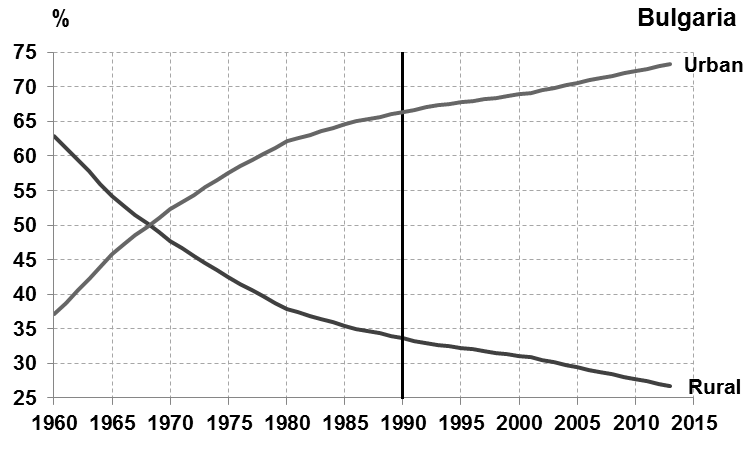
Fig. 1. The dynamics of urban and rural population in Bulgaria
Source: https://www.quandl.com/c/demography/rural-population-by-co untry.
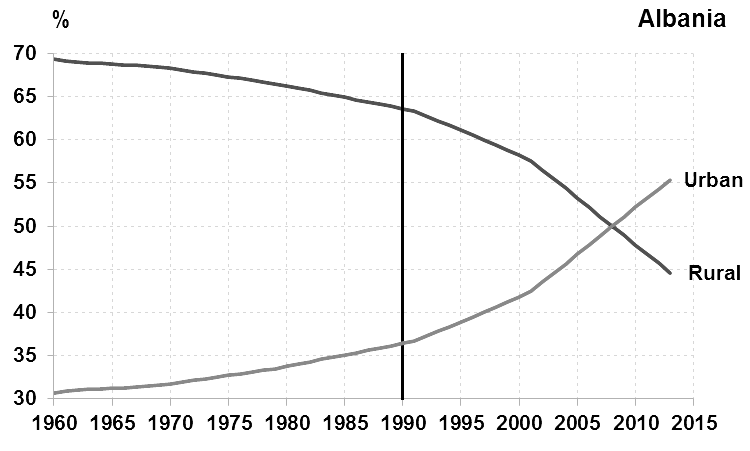
Fig. 2. The dynamics of urban and rural population in Albania
Source: https://www.quandl.com/c/demography/rural-population-by-co untry.
Another trend typical of all these countries is a significantly slowing down pace of urbanization and urban shrinkage. According to the studies carried out in the Eastern European countries (including studies in the territory of the former German Democratic Republic), this problem has economic reasons while its manifestations (including population decline and ageing, depreciation of national infrastructure, social polarization, and increased internal and external migration) pose a significant threat to social and political stability (Couch et al. 2005; Moos 2008; Grossman et al. 2012; Rumpel, Slach, and Koutsky 2013). Our analysis demonstrates that the slowing down pace of urbanization combines with increasing flows of external migration and this trend is typical almost of all countries under study. Thus, among three Baltic countries only Estonia managed to temporarily cease this trend in 2005, while in Latvia and especially in Lithuania the out-migration is still large-scale and is characterized by significant variations (see Figs 3–5).
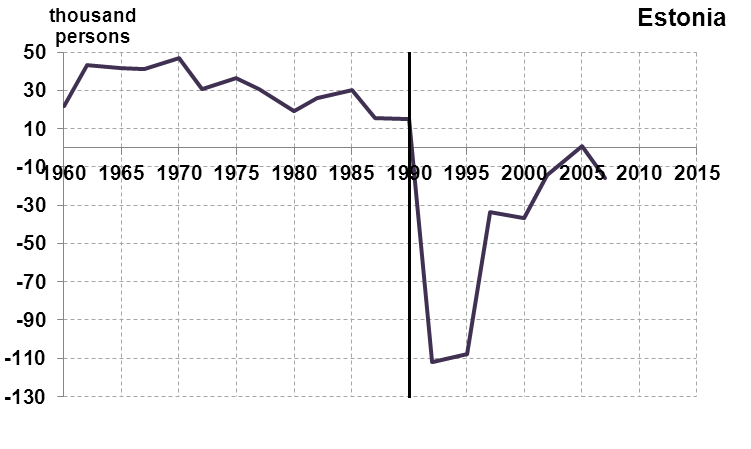
Fig. 3. The dynamics of net migration in Estonia
Source: https://www.quandl.com/c/demography/net-migration-by-country
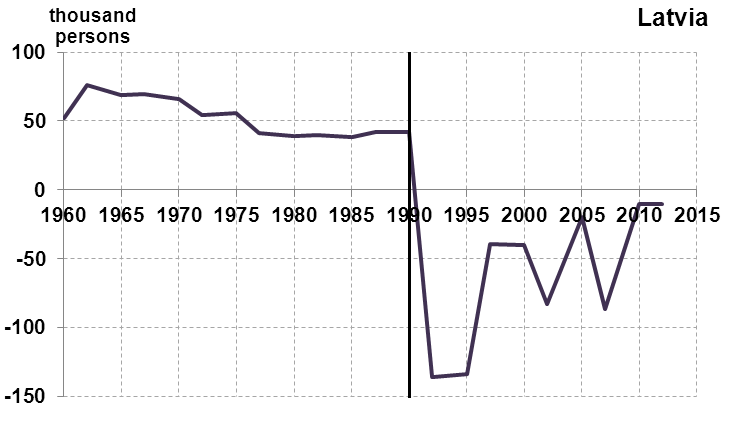
Fig. 4. The dynamics of net migration in Latvia
Source: https://www.quandl.com/c/demography/net-migration-by-country
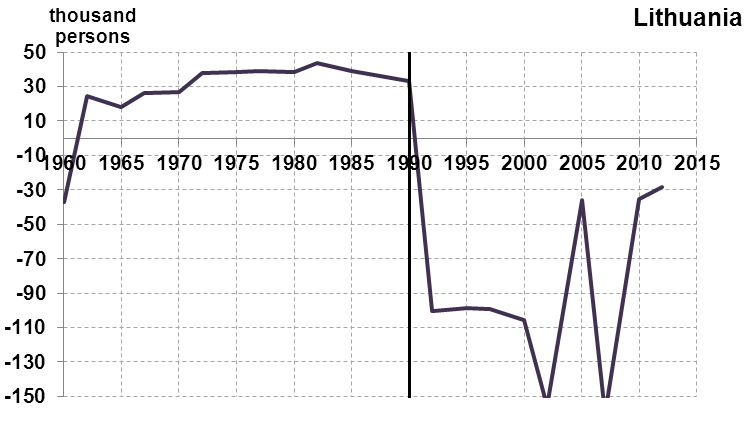
Fig. 5. The dynamics of net migration in Lithuania
Source: https://www.quandl.com/c/demography/net-migration-by-country
Along with the migration indicator, another important indicator of social changes is Gini index which represents a measure of inequality in relation to income distribution in the society. The more Gini index deviates from 0 and tends to 1, the larger is the income accumulated by a particular group of population. Our analysis of this indicator, performed for the group of countries under study, shows that in all these countries the transformation period is characterized by a sharp increase of inequality. One should note that despite differing scenarios of economic reforms the gap between Gini index values is insignificant both for Romania and Poland (see Figs 6, 7).
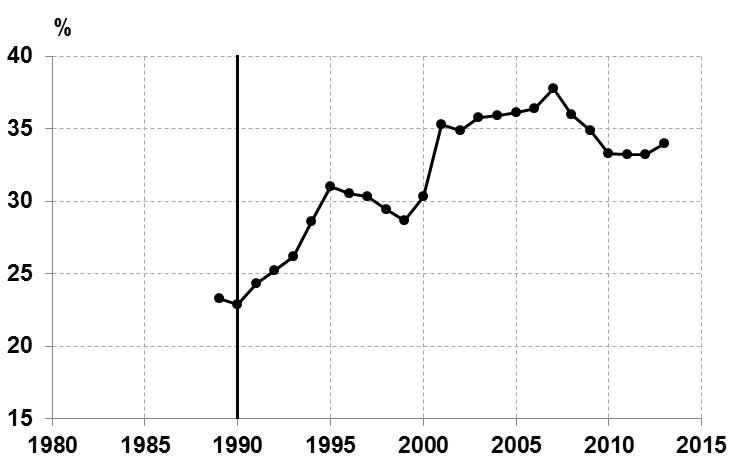
Fig. 6. The dynamics of Gini Index in Romania
Sources: http://www.siuc.edu/~fsolt/swiid/swiid.html; http://ec.europa.eu/ eurostat/web/income-and-living-conditions/data/database
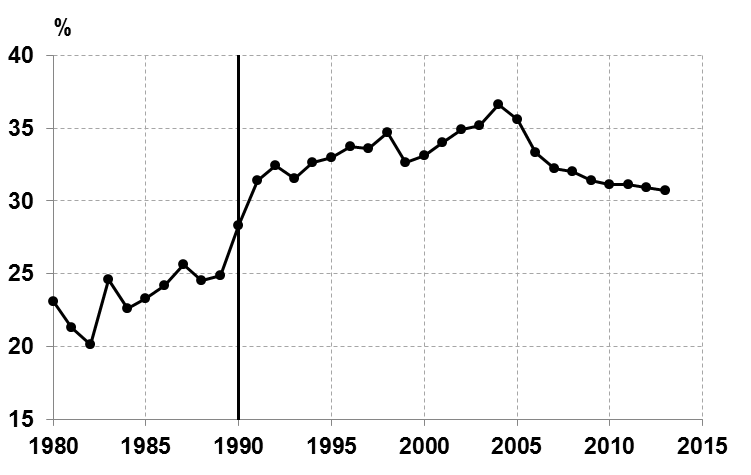
Fig. 7. The dynamics of Gini Index in Poland
Source: http://www.siuc.edu/~fsolt/swiid/swiid.html; http://ec.europa.eu/ eurostat/web/income-and-living-conditions/data/database
In general, in the countries of the studied group the Gini index values range from 0.23 to 0.39 with the average value of 0.34.
Countries with relatively stable Gini index and significant inflow of migrants are Hungary and Poland where almost a zero migration balance had been achieved by 2010. The situation had sound economic reasons. In these two countries among the factors of economic development (along with the inflow of foreign investment) were trade liberalization (first of all, trade with the EU), differences of the standard of living in comparison with Western European countries with adequate level of development of institutions and level of human capital; extensive domestic market (in Poland), technological modernization, and structural shifts. The cases of Poland and Hungary are, probably, the best demonstration of the fact that philosophy of liberalism facilitated overcoming of transformation decline. In Hungary, the economic reforms started in 1968. Consequently, by 1990 the country had developed a market ideology and the problem-solving skills of non-directive methods, as well as bred managers of a new type. In Poland, the early start of reforms was associated with the financial crisis of the 1980s. As a result, by 1989, the private sector employed 47 per cent of employees producing up to 28 per cent of the GDP. After political reforms of 1989, the law was changed2 and opened the way to foreign investment. In 1993, they amounted to US$ 2.5 billion in Hungary and US$ 1.7 billion in Poland, which were the highest among Eastern European countries. By this time inflation had been overcome: in 1993 it was equal to 35 per cent in Poland (as compared to 1991 when it was 500 per cent) and 22 per cent in Hungary which overcame the transformation decline and preserved the control over CPI. The started stable economic growth led to the long expected and significant improvement of living standards.
When characterizing social and economic evolution of Poland and Hungary, one should note that the economic model set in the course of transformations was mainly oriented towards the intervention of the western capital in the best national interests only in case the latter corresponds to its (capital's) interests. It seems that the Hungarian model can be characterized as a ‘factory’ for Central and Eastern Europe.3 This is the reason of duality of the economic structure implying the division of economy into foreign and domestic sectors (Kulikova 2013). In Poland, the extensive internal market attracted western investors. In particular, as it is shown in Roberts et al. (2008), the basic motive for privatization and inflow of foreign investments was rather entering new markets than harnessing new resources. Such an approach led to economic growth but did not promote the convergence of the standard of living with Western Europe.4
As shown by the post-war reconstruction in Western Europe (Erhard 2001), the high rates of national economic growth and welfare are possible under conditions of high employment rate, development and meeting of growing demand of domestic and foreign markets. However, as shown by reforms in Eastern European countries, the issue of high unemployment among working-age population still remains unachievable. During these years, this indicator varied on average between 3 to 17 per cent with maximum values between 21 and 26 per cent in Latvia and Albania (see Figs 8–9).
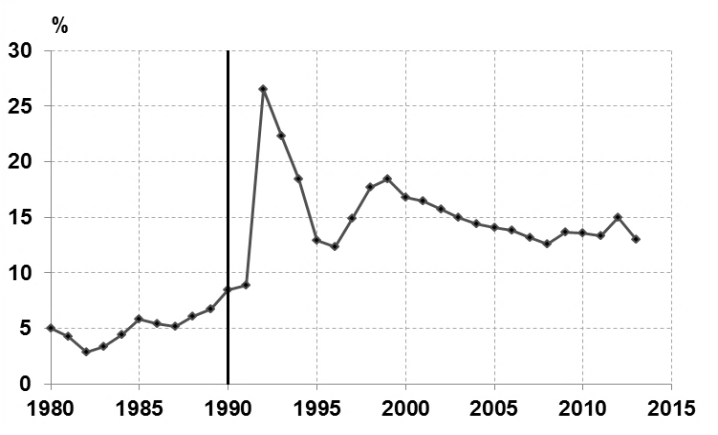
Fig. 8. The dynamics of unemployment rate in Albania (% of labor force)
Source: http://www.economywatch.com/economic-statistics/economic-indicators/Unemployment_Rate_Percentage_of_Labour_Force/
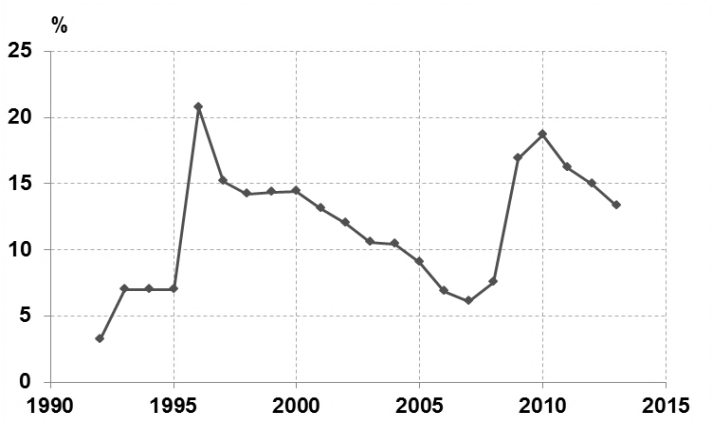
Fig. 9. The dynamics of unemployment rate in Latvia (% of labor force)
Source: http://www.economywatch.com/economic-statistics/economic-indicators/Unemployment_Rate_Percentage_of_Labour_Force/
One of the reasons of the high unemployment rate lies in different approaches to economic transformation. In south Eastern European countries (Romania, Bulgaria, and Albania), economic transformations proceeded at a slower pace and were accompanied with various political problems. It seems that initially these countries were less apt to accepting values of liberalism and market economy. 5 Thus, ‘the shock therapy’ rather facilitated the improvement of financial situation of the ruling elite than an efficient institutional reform. Corruption was increasing and individual interests prevailed over public interests along with observed further bureaucratization of the system.6 Changes happened not so much due to the authorities' will (as, e.g., in Poland, Hungary, and the Baltic Countries), but under the influence of social disturbances or the EU's impact. Romania was the only Eastern European country where political changes were accompanied by bloodshed, disunity of elites and constant political conflicts during the 1990s. Bulgaria, which by 1991 had a large foreign debt (120 per cent of the GDP), slowly conducted privatization. A number of deals were concluded at significantly low prices.7 Albania observed the process of robbery of population by means of financial pyramids, and in the beginning of 1997 it was on the verge of civil war. Actions of banks caused more than 300,000 victims; population lost about US$ 1.5–2 billion. Only much later the economic situation in these countries started to improve. By 2000 financial stabilization and inflow of foreign investments had started along with introduction of western management practice.
However, the Baltic countries in a number of ways better succeeded in conducting transformations. Thus, Lithuania tried to adopt the social-oriented economic policy (and population support) while Estonia and Latvia, on the contrary, would choose the earliest privatization and rigorous bankruptcy of inefficient enterprises. This had a particular impact only on Estonia. Among the Baltic countries it was the only one to pass through the transformation decline with the least losses (33 per cent of the GDP against 44 per cent in Latvia and 50 per cent in Lithuania). As time showed, in Latvia the chosen model of development of the banking sector and tourism (after manufacturing had lost its leading role) appeared to be inefficient. Lack of investors and, first of all, of governmental support for major manufacturing enterprises (the decision to ‘destroy the Soviet past forever’ was mainly caused by political motives) led to significant structural changes. In Latvia, the share of manufacturing in the GDP reduced from 30 per cent in 1991 to 14 per cent in 1994, and the share of the sector of other services increased from 27 per cent to 45 per cent. Low-tech industries formed the basis of manufacturing: food, textile, and food-processing industries, as well as production of construction materials, mainly represented by small and medium-sized enterprises. During the period of reforms the external debt was increasing and by 2010 it amounted to 162 per cent of the GDP. Latvia retained the transit function, important for the CIS countries (80 per cent of loading of sea ports). However, it almost lost mechanical engineering (first of all, the high-tech industries) and its scientific and technical potential. The established economy was dependent on the inflow of foreign investment and subject to external shocks (Vardomsky 2012).
As our study shows, all countries were following different paths towards the same goal. Some of them managed to timely adapt to new conditions (Poland and Hungary) and quickly get significant inflow of foreign investments promoting the economic recovery. Other countries which had high rates of bureaucratization and corruption (Romania, Albania, and Bulgaria) faced a long-term transformation crisis. According to our calculations, the standard of living recovered in Poland to the level of 1990 by the beginning of 1994, in Hungary it recovered by the middle of 1999, while in Romania – by 2001, and in Bulgaria – only by 2003. In absolute terms, the standard of living in Poland and Hungary was twice as high as in Romania, Albania and Bulgaria in the beginning of the 1990s. Since the Baltic countries had their own way of evolution, in 1990 their standard of living was relatively high (higher than in Poland, but by 20 per cent smaller than in Hungary). These countries observed a long-term transformation decline and, as a result, they achieved recovery of the standard of living only by 2003–2004 (Lithuania and Latvia). Only Estonia relatively succeeded in increasing the standard of living: the 1990 level had been achieved by the beginning of 2000, and in 2004 it exceeded the pre-transformation standard of living by 43 per cent.
Among the analyzed indicators there is a factor, probably a key one, which points out the unresolved issues and problems of social evolution in every Eastern European country. All analyzed indicators directly or indirectly refer to transformation processes with different dynamics and trends. However, there is a specific indicator of the demographic trend (birth and death rates per 1,000 people). For two countries – Poland and Estonia – this indicator is at zero level. For Albania it is characterized by insignificant positive trend, while other countries have a negative indicator (see Figs 10–14). In our opinion, the dynamics of this indicator results from the internal conflict between development goals and related transformation policy. In fact, Europe has a ‘Core’ and a ‘Periphery’ with similar ultimate goals but with different opportunities of social and economic transformations. In its turn, the ‘Periphery’ is not homogeneous with Bulgaria, Romania, and Albania forming the ‘periphery of the Periphery’ while the Baltic countries occupy the buffer zone between them and countries which moved forward, that is Hungary and Poland (the Czech Republic and Slovakia can be added to the list as well).
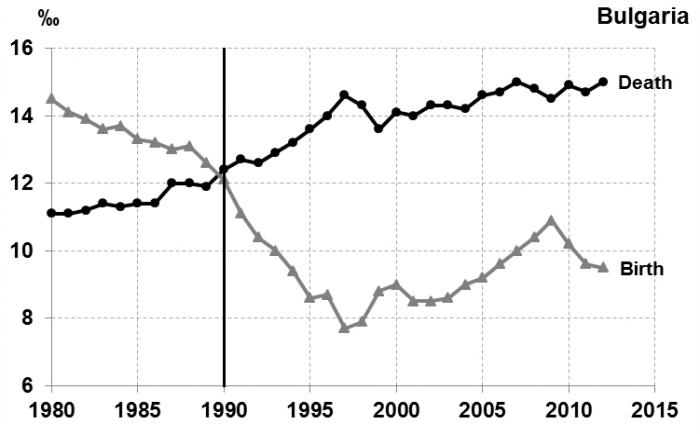
Fig. 10. Demographic trends in Bulgaria
Source: http://databank.worldbank.org/data/views/variableSelection/sele ctvariables.aspx?source=gender-statistics#
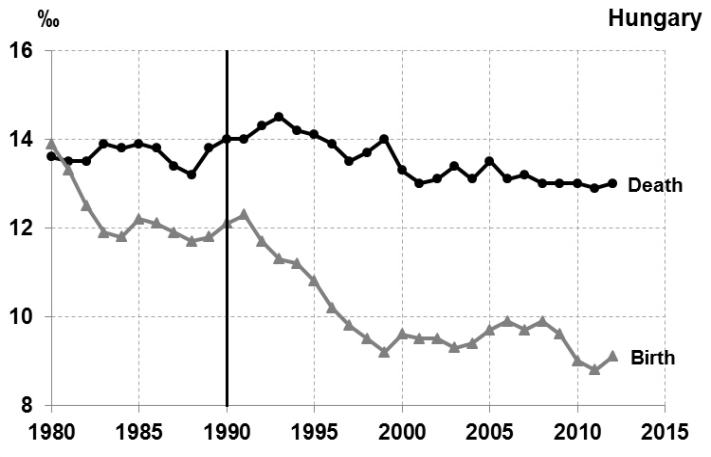
Fig. 11. Demographic trends in Hungary
Source: http://databank.worldbank.org/data/views/variableSelection/sele ctvariables.aspx?source=gender-statistics#
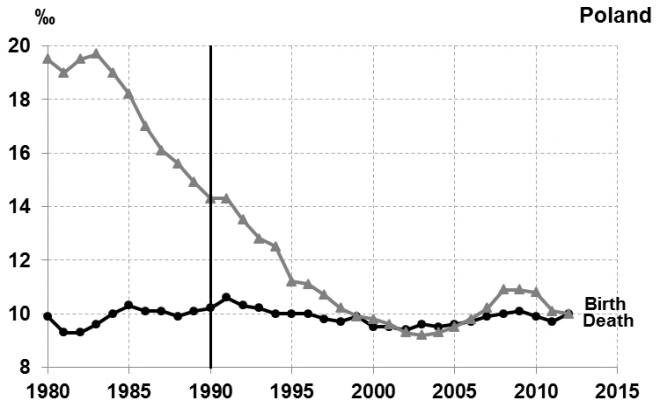
Fig. 12. Demographic trends in Poland
Source: http://databank.worldbank.org/data/views/variableSelection/selec tvariables.aspx?source=gender-statistics#
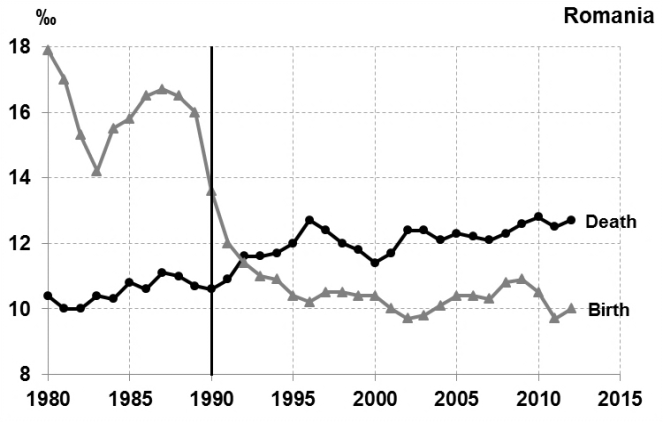
Fig. 13. Demographic trends in Romania
Source: http://databank.worldbank.org/data/views/variableSelection/selec tvariables.aspx?source=gender-statistics#
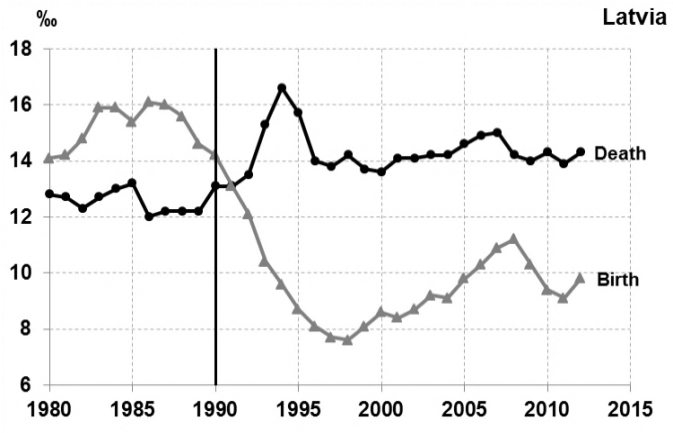
Fig. 14. Demographic trends in Latvia
Source: http://databank.worldbank.org/data/views/variableSelection/selec tvariables.aspx?source=gender-statistics#
To understand the internal causes of this clusterization of countries, we should refer to Fig. 15.
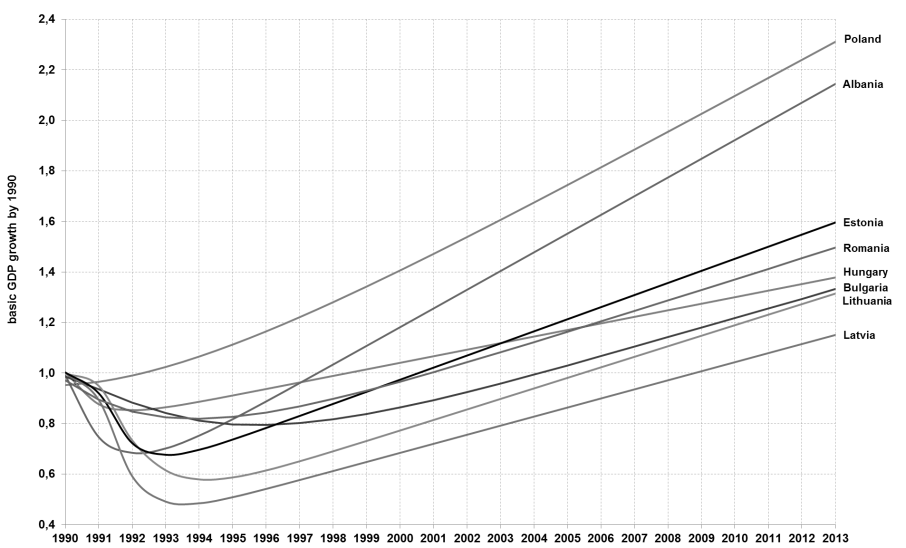
Fig. 15. Basic real GDP growth
Source: http://www.conference-board.org/data/economydatabase/
First of all, one should pay attention to the trajectory of Poland which adopted the ‘shock therapy’ policy and managed to minimize the duration of the initial phase of reforms. It points to the fact that within the Polish society there was adopted a consensus about the ways of development and the price which both the political elite and citizens were ready to pay. Besides, the country's extensive domestic market promoted the acceleration of economic growth.
Albania's trajectory of development is very impressive, but it is mainly characterized by the low starting point. The initial phase of reforms was followed by a significant decline which lasted for almost eight years.
Hungary, similar to Poland, had a dynamic initial phase of reforms, but under intense competition in foreign markets the lack of domestic demand generally hindered economic growth. In particular, this is the reason why 72 per cent of the Hungarians believe that the standard of living in their country is lower than during the communist period (Pew Research Center 2009). 8
Two countries, Lithuania and Latvia – as is shown by the trajectory of their development – experienced both a significant decline and a protracted period of reforms. The events there prove that these two countries have failed to reach a proper internal consensus and have made certain mistakes since their political goals prevailed over the economic ones. At present, these countries' developmental potential is indeterminate. Meanwhile, despite the significant decline Estonia managed to choose the right strategy of both institutional and structural changes favorable to increasing and sustainable economic growth.
CONCLUSION
The analysis of the transformation processes in Eastern European countries over the last quarter of a century shows that the transition to market economy was inevitable. Its primary motive was liberal values, which, however, were vaguely perceived by the majority of population. It is clear that results of the transition, in particular, in social sphere, did not meet the initial expectations of the majority of population. When the reforms started most people did not expect to face such social phenomena as increasing economic inequality, high unemployment rates, and emigration as well as growing demographic crisis. The gap in the standard of living (in comparison with Western countries) has not been overcome and remained significant. Moreover, in certain Eastern European countries the price for the transition to market economy appeared to be really high.
However, this negative social background is not homogeneous. Some countries conducted ‘smoother’ reforms. The experience of Hungary and Poland shows that it was achieved due to the consensus on the developmental goals and consolidation of view of economic challenges. The countries that appropriately used their competitive advantages in the global market (including domestic market volume and scientific and technical opportunities) have achieved leading GDP growth rates.
On the other hand, the uneven processes of reforms led to clusterization of Eastern European countries and development of the European ‘periphery of the “Periphery”’. It resulted from the absence of public consensus and from ignoring (mainly by the political elites) of goals stated at the outset of reforms. By the example of reforms in Latvia, which failed in economic terms, one can see the consequences of political populism based on antagonistic imperatives.
We can deduce the following common characteristics of social and economic evolution of Eastern European countries after 1990: 1) an acute process of stratification and social differentiation in the society with weak middle class; 2) weakening of national innovation potential; 3) prevalence of western capital and failure of national capital to compete in key economic areas; and 4) increasing debt level.
One can distinguish three phases of evolution: the first phase (from 1990 to 1994/1999) refers to the post-communist transformation and development of institutions of a democratic society and market economy; the second phase (from 1999 to 2008) – to the period of catching-up economic growth under conditions of close integration with the EU; the third phase (after 2009) is the phase of real competition under conditions of the systemic economic crisis.
NOTES
1 At least one should recall Joseph Stiglitz's statement: ‘Seldom the gap between expectations and reality has been greater than in the case of the transition from communism to the market’ (Stiglitz 2002).
2 In 1988 in Hungary a tax reform was conducted which simplified taxation and reduced the tax burden on production. In 1989, there was adopted the law on business entities and in 1990 there was adopted the Foreign Investment Act (for details see Usievich 2002). In Poland, in 1991 there were adopted the Law on Entrepreneurship and Foreign Investment Law.
3 In 2013, the export volume in Hungary amounted to 94 per cent of the GDP with high-tech products making 25 per cent of the export volume.
4 In Poland and Hungary, the GDP per capita only amounted to 50 per cent of that of the standard of living in Germany in 2014. For comparison, in Hungary it was equal to less than 49 per cent of that of the standard of living in Western Germany in 1990. As for Poland, one can observe significant increase in the standard of living. The reduced inflow of foreign investments after the 2008 crisis shows that under existing conditions the gap in the standard of living will hardly change in the next decades.
5 According to the latest studies, in Romania, for example, there prevail such traditional values as religious authority, risk avoidance, concentration on discipline and conservatism. The young generation (20-year-olds) generally share values of their parents (50-year-olds) even if they sometimes judge parents for complicity to the communist regime. Such values, and, in particular, conservatism and hierarchy, have an impact on population requirements to authorities. In their opinion, the state authority should take more social responsibilities. At the same time, population considerably disapproves such values of free markets as autonomy, professionalism, and risk-taking (Friedlmeier and Gavreliuc 2013).
6 According to the Corruption Perceptions Index (Transparency International), Bulgaria and Romania share the 69th place, and Albania ranks 110th in the world. For comparison: Poland ranks 35th and Hungary ranks 47th. According to the Index of Economic Freedom calculated by the Fraser Institute, up to 2000 Bulgaria and Romania had the bloated state apparatus and Albania delayed the legislative reform (Fraser Institute 2014).
7 By the mid-1997 a quarter of assets meant for privatization had been privatized. By 2000 two thirds of such assets had been privatized.
8 The highest per cent is observed among Eastern European countries.
REFERENCES
Couch, Ch., Karecha, J., Henning, N., and Deiter, R. 2005. Decline and Sprawl: An Evolving Type of Urban Development – Observed in Liverpool and Leipzig. European Planning Studies 13 (1): 117–136.
Erhard, L. 2001. Wealth for Everyone. Moscow: DELO. Original in Russian (Эрхард, Л. Благосостояние для всех. М.: ДЕЛО).
Fraser Institute. 2014. Economic Freedom of the World 2014. Annual Report. Fraser Institute. URL: http://www.freetheworld.com.
Friedlmeier, M., and Gavreliuc, A. 2013. Value Orientations and Perception of Social Change in Post-communist Romania. In Albert, I., and Ferring, D. (eds.), Intergenerational Relationships in Society and Family: European Perspectives (pp. 119–130). Bristol, UK: Policy Press.
Gatzweiler, F., and Hagedorn, K. (eds.) 2003. Institutional Change in Central and Eastern European Agriculture and Environment. Vol. 4. Food and Agricultural Organization of the United Nations. Berlin: Humboldt University. Original in Russian (Институциональные изменения в сельском хозяйстве и окружающей среде Центральной и Восточной Европы. Часть 4. Продовольственная и сельскохозяйственная организация ООН / ред. Ф. Гацвейлер, К. Хагедорн. Берлин: Университет Гумбольдта).
Grossmann, K., Haase, A., Arndt, T. et al. 2012. How Urban Shrinkage Impacts on Patterns of Socio-Spatial Segregation: The Cases of Leipzig, Ostrava, and Genoa. In Yeakey, C. C., Thompson, V. S., and Wells, A. (eds.), Urban Ills: Post Recession Complexities of Urban Living in Global Contexts (pp. 241–267). Lanham: Lexington Books.
Hayek, F. A. 1944 [2005]. The Road to Serfdom. London and Chicago: University of Chicago Press.
Hayek, F. A. 2001. Individualism and Economic Order. Moscow: Izograf. Original in Russian (Хайек, Ф. А. Индивидуализм и экономический порядок. М.: Изограф).
Hayek, F. A. 2005. The Road to Serfdom. Moscow: Novoe izdatel'stvo. Original in Russian (Хайек Ф. А. Дорога к рабству. М.: Новое издательство).
Kirzner, I. 2001. Competition and Entrepreneurship. Transl. by Prof. A. N. Romanov. Moscow: UNITY-DANA. Original in Russian (Кирцнер, И. Koнкуренция и предпринимательство. М.: ЮНИТИ-ДАНА).
Klaus, V. 2006. The Economic Transformation of the Czech Republic: Challenges Faced and Lessons Learned. Economic Development Bulletin no. 6. February 14. The Cato Institute. URL: http://www.cato. org/publications/economic-development-bulletin/economic-transfor- mation-czech-republic-challenges-faced-lessons-learned.
Kulikova, N. V. (ed.) 2013. Results of Transformation in Central and Eastern European Countries (Socio-Political and Economic Issues). Moscow: IE RAN. Original in Russian (Куликова Н. В. Результаты трансформации в странах Центральной и Восточной Европы (общественно-политический и экономический аспекты). М.: ИЭ РАН).
Moss, T. 2008. Cold Spots of Urban Infrastructure: Shrinking Processes in Eastern Germany and the Modern Infrastructural Ideal. International Journal of Urban and Regional Research 32 (2): 436–451.
Pew Research Center. 2009. End of Communism Cheered but Now with More Reservations. 02 November. URL: http://www.pewglobal.org/2009/ 11/02/end-of-communism-cheered-but-now-with-more-reservations/.
Prischepov, A. V., Radeloff, F. K., and Muller, D. 2012. Influence of Institutional Change and Local Factor on Percentage and Distribution of Abandoned Agriculture Lands in Post-Soviet Eastern Europe. Leibniz, Halle: Institute of Agricultural Development in Central and Eastern Europe (IAMO). Original in Russian (Прищепов, А. В., Раделофф, Ф. К., Мюллер, Д. Влияние институциональных изменений и локальных факторов на процент и пространственное распределение заброшенных сельскохозяйственных земель в постсоветской Восточной Европе. Лейбниц: Институт аграрного развития в Центральной и Восточной Европе (IAMO)).
Pyrkosz, D. S., Grzebyk, B., and Miś, T. 2014. Changing Trends of the Socio-Economic Development of Rural Areas in Eastern Poland. In Babjakova, B., Bandlerova, A., Brown, D. L. et al. (eds.), Social and Economic Transformations Affecting Rural People and Communities in Central and Eastern Europe since 1990 (pp. 18–29). Nitra: Slovak University of Agriculture in Nitra.
Roberts, B. M., Thompson, S., and Mikolajczyk, K. 2008. Privatization, Foreign Acquisition and the Motives for FDI in Eastern Europe. Review of World Economics (Weltwirtschaftliches Archiv) 144 (3): 408–427.
Rumpel, P., Slach, J., and Koutsky, J. 2013. Shrinking Cities and Governance of Economic Regeneration: The Case of Ostrava. Business Administration and Management 1: 113–127.
Stiglitz, J. E. 2002. Globalization and its Discontents. London: Penguin Books.
Usievich, M. A. 2002. The Decade of Reforms in Hungary. The 1990s of the 20th Century. Novaya i noveishaya istoriya 5: 80–97. Original in Russian (Усиевич, М. А. Десятилетие реформ в Венгрии. 90-е годы 20 века. Новая и новейшая история 5: 80–97).
Vardomsky, L. B. 2012. Social and Economic Development of Post-Soviet Countries: Summary of 20 Years. Мoscow: IE RAN. Original in Russian (Вардомский Л. Б. Социально-экономическое развитие постсоветских стран: Итоги двадцатилетия. М.: ИЭ РАН).
World Bank. 1996. World Development Report 1996: From Plan to Market. New York: Oxford University Press.





